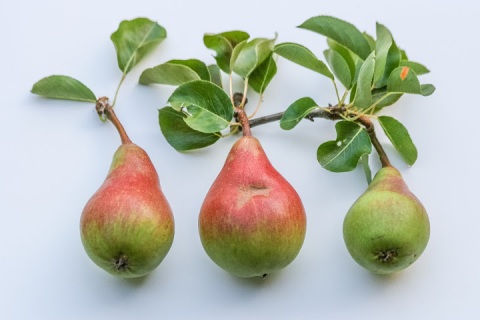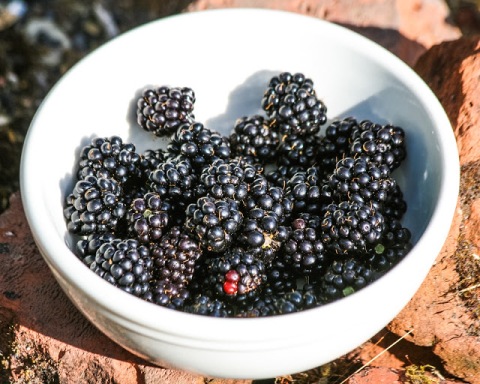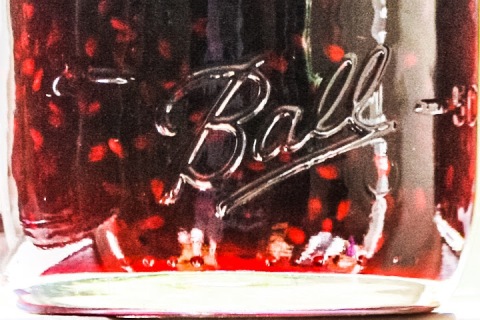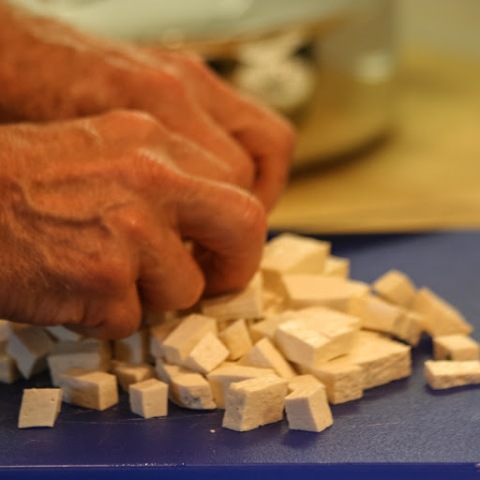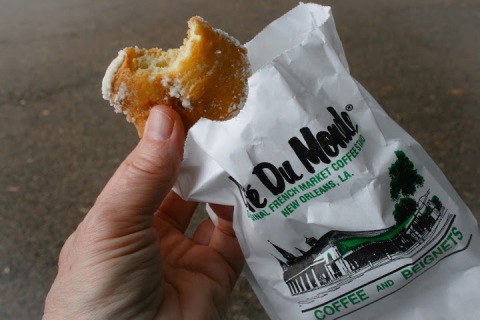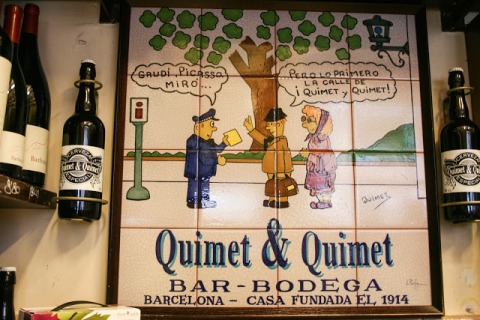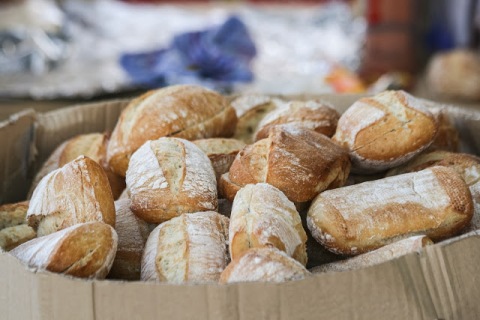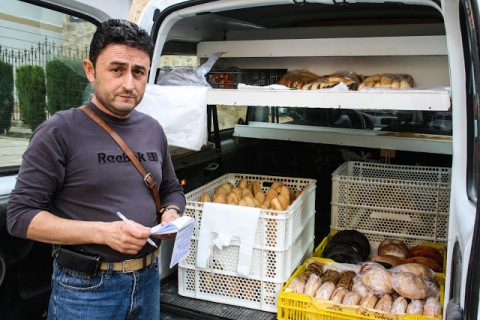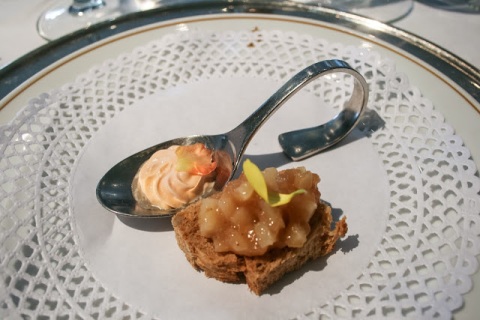Moroccan Pickled Carrots
August 3, 2016
This summer is the first time I’ve experienced pickling anything. I’ve already written about pickled red onions in my June 13th post. After reading that, one of the patrons at the library thought I might like her recipe for Pickled Moroccan Carrots. And I do!
I used colored carrots for interest and did not peel mine since they were organic. I did not have white balsamic vinegar, so I used a combination of regular balsamic vinegar and apple cider vinegar. These carrots are a bit spicy!
Moroccan Pickled Carrots
Tightly pack into one quart jar:
1 lb carrots, peeled and thinly sliced thinly into sticks
1 lemon, sliced
4 garlic cloves, thinly sliced
In saucepan over medium heat, lightly toast:
1-1/2 tsp coriander seeds
1-1/2 tsp cumin seeds
Then add:
2 tsp crushed pepper flakes
3 Tbsp sugar
1 c water
1 c white balsamic vinegar
1-1/8 tsp cinnamon
Bring to a boil. Then slowly and carefully pour into jars. Fill to 1/4-inch head space. Seal and refrigerate. Carrots are ready to eat in 3 – 5 days. Keep up to one month in refrigerator.
The Poetry of Pears
July 23, 2016
Free Food! Blackberry Season
July 17, 2016
It’s that time of year when I can go a few steps out my front door and pick a bowlful of blackberries for breakfast. Our yard is pretty much a wild mess, and I vow to someday cut back or get rid of the blackberry brambles, but now is when my procrastination pays off. Every day there are a few more berries ripe for the picking. A free serving of fruit!
One morning this week I even gathered sufficient berries to make a small batch of jam. I’ve written about my friend Shirley’s jam before (see link here) but I’ve never provided her recipe. She was generous enough to give it to me before she retired.
Shirley’s Blackberry Jam
In a large kettle mix together:
5 c mashed blackberries (no need to remove seeds)
1 box Sure-Jell
a little dab of margarine (I used butter)
Cook on high until the mixture is really boiling and then add about 5-1/2 c sugar. Continue to cook on high until it comes to a full rolling boil that you can’t stir down. Then cook for one minute more. Remove from heat and ladle into jars.
I don’t worry about sealing my jars properly because I put my jam in the freezer. But you can also do a water bath or follow the directions in the Sure-Jell box.
Sweet and Sour Red Cabbage
June 16, 2016
Here is another winning recipe. It has been making the rounds among my sisters. We all like it. It uses red cabbage, which up until now I rarely bought. The bacon is the secret ingredient that adds a lot of flavor. I didn’t have much bacon on hand, so I added some ham as well. Yummy.
Sweet and Sour Red Cabbage
Cut 1/4 lb bacon into pieces and fry.
Add to the drippings a chopped onion and one small red cabbage, sliced thinly.
Saute until limp. While the cabbage is cooking, mix together in a small bowl:
1/4 c. vinegar (I used apple cider vinegar)
1/4 c brown sugar
1/2 tsp salt and pepper
Pour over cabbage and cook for an additional 15 – 20 minutes.
Enjoy!
Pickled Red Onions
June 13, 2016
I like getting recipe recommendations from friends and family. My friend Bonnie passed along this super-simple recipe for Pickled Red Onions. They seem like an appropriate addition to my repertoire of summer foods. They add a crunchy, tasty bite to sandwiches, hamburgers and salads.
Bonnie says she reuses the brine, simply adding more onion or peppers as the jar empties.
Thinly slice one big red onion.
Bring to a boil:
1 c apple cider vinegar
1 c sugar
1 Tbsp salt
Cool a bit, then pour over sliced onion. Store in refrigerator.
Cooking with Tofu
June 1, 2016
I have never cooked with tofu, so I really appreciated that my friend Carol arranged another cooking demonstration at her house — this time her good friend Don made Thai Noodle Bowls with Almond Butter Tofu. He found the recipe online on the Minimalist Baker website. I have copied that recipe below for your convenience.
I am now a tofu convert. I know I will make this recipe again. It was so easy to make! And flavorful (not too spicy). I could easily eat the leftovers cold for lunch at work.
You can find tofu in the refrigerator section of most grocery stores. Don buys”extra firm” tofu. He removes the packaging, drains any liquid, and then sets the tofu on an absorbent towel under a cutting board for about 30 minutes to remove even more moisture. Afterwards, the tofu feels slightly spongy, but firm. He sliced the tofu into squares of roughly 1/2-inch.
The tofu would take only 10 or 15 minutes to cook, so before moving on to that step, Don assembled the salad and tossed it with the dressing.
Don also mixed up the almond butter sauce and had it ready to cook with the tofu. He likes his tofu somewhat crisply browned on the outside, so he set a cast iron pan on high and heated the sesame oil. He lowered the heat to medium-high and then added the tofu and cornstarch. After browning about ten minutes on each side, he added the almond butter sauce and warmed through.
During the final minutes of cooking, Don put the rice noodles to boil in a large pot of water. They were cooked in a couple of minutes.
In less than 30 minutes, it was time to eat. Truly delicious!
Here’s the detailed recipe so you, too, can try this at home:
Author: Minimalist Baker
Recipe type: Entrée
Cuisine: Thai, Vegan, Gluten Free
Serves: 2
INGREDIENTS
TOFU* and ALMOND BUTTER SAUCE
8 ounces (227 g) extra firm tofu
3 Tbsp (45 ml) sesame oil, divided
2 Tbsp (32 g) salted creamy almond, cashew or peanut butter
1 Tbsp (15 ml) tamari (or soy sauce if not GF)
1 Tbsp (15 ml) lime juice
1-2 Tbsp (15-30 ml) maple syrup or coconut sugar
1 birds eye chili, crushed (or sub 1/4 tsp red pepper flake)
3 Tbsp (21 g) cornstarch
SALAD
2 cups (244 g) thinly sliced or ribboned* carrots (~2 carrots)
1 cup (104 g) cucumber, sliced on a bias, then halved (~1 small cucumber)
optional: 1/2 cup (75 g) chopped red bell pepper
1/2 cup (50 g) thinly sliced diced green onion
1/2 cup (30 g) fresh cilantro or basil, torn/chopped
DRESSING
2 cloves garlic, minced (1 Tbsp or 6 g)
1 fresh or dried birds eye chili, crushed (more to taste), or sub 1/4 tsp red pepper flake
1 Tbsp (15 ml) maple syrup, plus more to taste
2 tsp tamari (or soy sauce if not gluten free)
1 Tbsp (15 ml) lime juice
2 Tbsp (30 ml) rice vinegar (or sub white or apple cider vinegar with varied results)
1 Tbsp (15 ml) sesame oil
RICE NOODLES
5 ounces (141 g) very thin rice noodles, prepared according to package directions
INSTRUCTIONS
Start by wrapping tofu in a clean towel and setting something heavy on top (like a cast iron skillet) to press out excess moisture for 10 minutes. Set aside.
Prepare the tofu sauce in a medium mixing bowl by whisking together 1 Tbsp sesame oil, almond butter, tamari, lime juice, maple syrup, and 1 crushed chili. Taste and adjust seasonings as needed, adding more tamari for saltiness, lime juice for acidity, chili pepper for heat, or maple syrup for sweetness. Set aside.
Next, prepare rice noodles according to package instructions, then rinse with cold water, drain thoroughly, and set aside.
Prep vegetables next. Set aside.
Prepare salad dressing by adding all ingredients to a small mixing bowl (or jar) and whisking (or shaking vigorously) to combine.
Taste and adjust flavors as needed, adding more chilies for heat, tamari for saltiness, lime juice for acidity, or maple syrup for sweetness. Set aside.
Heat a large skillet over medium heat and cut pressed tofu into small rectangles. Toss in 3-4 Tbsp cornstarch (they should be well coated) and sauté in 2 remaining Tbsp sesame oil, flipping once browned on the underside to ensure even browning – about 5 minutes total.
Add the almond butter sauce and stir gently to combine. Cook for another 3-4 minutes, stirring gently to ensure even cooking on all sides. Remove from heat and set aside.
To assemble, divide noodles, vegetables and tofu among serving bowls. Serve with dressing. For more heat, serve with sriracha or chili garlic sauce.
Best when fresh, though leftovers keep well when stored separately in the refrigerator up to 3 days.
Notes
* If you’re looking for an alternative to tofu, steamed edamame, roasted salted cashews, Curry Spiced Cashews, or roasted salted peanuts would work well here!
* To ribbon carrots, rinse, remove outer skin with a vegetable peeler, and then make “noodle ribbons” with the vegetable peeler by running along the edge of the carrot. Each carrot should make about 10 noodles!
* Salad dressing adapted from Thai Kitchen and my Vegan Papaya Salad.
Nutrition Information
Serving size: 1 serving (of 2) Calories: 622 Fat: 34 g Saturated fat: 4.8 g Carbohydrates: 64.1 g Sugar: 22 g Sodium: 838 mg Fiber: 5.3 g Protein: 16.5 g
New Orleans: The Food, the Food
December 18, 2015
“Living in New Orleans is like drinking blubber through a straw. Even the air is calories. The atmosphere is permeated by rays of roux and bubbles of cornbread. Gumbo gives off a cloud of cayenne-flavored fat that envelops the passerby. Fish fries and shrimp are breaded all around the innocent.”
— Andrei Codrescu, “Fantastic Feast,” from New Orleans Mon Amour

Our last meal in New Orleans was lunch at the Ruby Slipper — I ordered a pulled pork sandwich with cole slaw.
“This was the New Orleans we all knew and loved — the place where you talk about food in the rare moments when you don’t happen to be eating any.”
— Julia Reed, The House on First Street
“Be a castaway in New Orleans. Smell the coffee and creosote. Do not sink into the everydayness of your life. Fight despair. Find treasure.”
— Billy Southern, “On a Strange Island,” from Unfathomable City
Finding treasure on your plate is easy in New Orleans. Needless to say, the food was one of my favorite things about the city. I came armed with a long list of iconic Southern foods I wanted to taste, and I managed to make quite a dent in my list before it was time to go: po’ boy sandwich, muffuletta, grits, catfish, shrimp, barbecue, gumbo, pralines, chicory coffee, beignets, and even oysters (I ate one, and I learned I still don’t like them!).
“It had to be New Orleans, I believed. In New Orleans, you walk on roads flecked with crushed oyster shells, and there is a whole culture of oysters, a mystique. . . . In New Orleans, oysters are almost an art form. You eat them covered in spinach and garlic and bacon and cheese, eat them roasted, baked, even grilled over an open flame in their shells. . . . And, of course, all over town, I ate them in po’ boys and oyster loaves, dripping with hot sauce and tartar sauce, with cold root beer on the side. I was not just eating food. I was consuming culture, and as I came to love the city, I came to love its oysters.”
— Rick Bragg, My Southern Journey: True Stories from the Heart of the South
New Orleans offers the hungry traveler a wide array of places to satisfy hunger — from the Lucky Dog street cart to the white-tableclothed fancy restaurant, like Antoine’s.
“There can be only one Antoine’s.”
— Frances Parkinson Keyes, Dinner at Antoine’s
We couldn’t leave New Orleans without tasting the beignets and chicory coffee at the Cafe du Monde.
“This Cafe du Monde couldn’t be anywhere except in New Orleans, like Antoine’s and Mardi Gras. And it isn’t only unique. It’s — it’s real.”
— Frances Parkinson Keyes, Dinner at Antoine’s
Spanish Tapas
October 30, 2015
“A Spanish tapa bar is one of mankind’s inspired inventions . . .”
— James Michner, Miracle in Seville
With their late lunches (2:30 – 4:30) and very late dinners (9:30 – 11:30), how do the Spanish not faint from hunger during the day? The answer is tapas.
“[A] tapa, a word derived from the verb tapar, which mean ‘to cover.'”
— Talia Baiocchi, from Sherry: The Wine World’s Best-Kept Secret
” . . . tapas originated . . . in the nineteenth century, when bars and taverns used to keep saucers over glasses of sherry to both keep the flies our and preserve the wine’s aroma. . . . on top of the saucer, barkeepers would generally offer a small slice of jamon, either alone or on top of a piece of bread, as a welcoming gesture. This, as it’s told, eventually evolved into a collection of small dishes meant to be consumed in bars, with wine.”
— Talia Baiocchi, from Sherry: The Wine World’s Best-Kept Secret
Carol and I loved sharing two or three tapas and calling it a meal. We were novices at making selections. Even when the menus included English descriptions, the arrival of the small plates to our table was invariably a surprise.
Once, for example, we ordered chunks of chicken on a skewer for one dish, beef with mushrooms for our second, and a tapa of potatoes brava. We did not know that each of the meat dishes would come with its own side of potatoes, so our meal was very heavy on the starch! The potatoes were so delicious, though, braised and crusty on the outside, warm and soft on the inside. Hard to resist. Total cost, including two small beers: 10 euros.
After that, we tried to include at least one vegetable dish for a more balanced meal, which was a good strategy!
Another time we ordered a tapa of shrimp fried in batter. We were expecting something like a dish of popcorn shrimp. Instead, what came to our table were four large shrimp fritters, thin pancakes fried to crispy perfection. Delicious.
“Nobody drank without eating — it would have been thought uncivilized . . .”
— Laurie Lee, As I Walked Out One Midsummer Morning
Of course, you could not eat tapas without drinking, so if you stopped in a tapas bar for a late morning pick-me-up, you might actually find yourself drinking a small beer before noon. (It’s been known to happen.)
We had the chance to see a tapas-making demonstration during our Andalusian train tour. Alejandro, one of the Al Andalus chefs, made three batches of tapas, which we got to sample: a cold tomato soup called salmorejo; a melon, tomato and cheese salad; and a pate of black olives on toast rounds. Yum!
The Food of Spain
October 26, 2015
” . . . it cannot be denied that you get more enjoyment out of visiting a famous town if you are well housed and well fed.”
— W. Somerset Maugham, “Somerset Maugham’s ‘Spanish Journey’: Interlude at Oropera,” Chicago Tribune, March 3, 1985
I returned from Spain very well fed. Truly, the food of Spain was one of the highlights of my trip.
Ham seems to be emblematic of Spain, and it is a delight to still see so many small, independent butcher shops in the residential neighborhoods. Many of the tapas bars displayed hams hanging from their ceilings. We even saw ham-flavored potato chips for sale!
“One of the glories of Spain is her bread, which the Romans remarked upon a thousand years ago, and which is said to be so good because the corn is left to last possible moment to ripen upon the stalk. It is the best bread I know, and its coarse, strong, springy substance epitomizes all that is admirable about Spanish simplicity. It is rough indeed, and unrefined, but feels full of life . . .”
— Jan Morris, Spain
My friend Carol had forewarned me that Spain has the best bread in the world, so we both threw diets to the wind and took every opportunity to partake. Bread was offered at every meal. When I was in Baeza, I saw a man selling bread from the back of his van parked in the church square. I imagine this was a regular stop, because the town women steadily approached to fill plastic bags with their purchases.
While we were on our week-long train tour with Al Andalus, all meals were provided, and we were fed very well indeed. Lunches and dinners were served either on the train or at a fine restaurant at one of our stops. Each lunch and dinner was a four-course meal, and the menus were predetermined — everyone was served the same dishes. It was a relief to leave the food selection to our expert hosts; each dish was a surprise and utterly delicious. Here is an example of one such lunch, which we ate at the parador in Ronda:
When we were on our own (not on the train tour), Carol and I usually ate more casually. We found a perfect way to sample lots of savory dishes by sharing two or three small plates of tapas. The selection was varied and not at all simply snacks; tapas were rather like down-sized portions of complicated or savory dinner dishes. One of our favorites was a plate of roasted artichokes, which I finally had the presence of mind to photograph after we had already eaten (inhaled) five of the six beautifully prepared artichokes on the plate.
Truly, I cannot imagine going hungry in Spain. I was so impressed that Spain has not lost the tradition of small, independent shops and restaurants to cookie-cutter chain stores. Each shop had so much individual character and many were cluttered with abundant and varied inventory. How I wish that towns and cities in the United States could replicate this way of living.
One experience that Carol and I were determined not to miss was eating churros and chocolate. After walking through a festival and street fair in Alcala, we decided churros and chocolate would provide a much-needed energy boost. My oh my! The chocolate was nothing like the hot chocolate we drink at home. This was on the order of a thin pudding, perfect for dipping sugar-glazed churros into.
Food was such a pleasurable part of my trip to Spain, that I will be revisiting the subjects of tapas and Barcelona’s Mercat de la Boqueria in future blog posts. For today, I want to mention one more Spanish food surprise: Nespresso! All the hotels we stayed in, the Al Andalus luxury train, and many shops and restaurants offer espresso drinks made on Nespresso machines (or similar k-cup-type machines). It makes me wonder if the barista’s art of hand-crafted espresso drinks is dying in Spain. I don’t see the same trend in Seattle where the barista still rules the coffee shops here.




